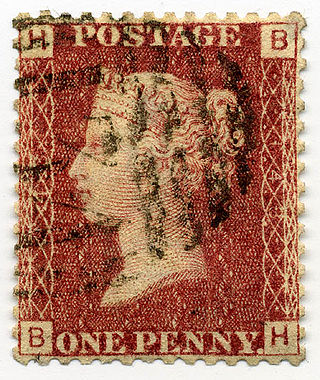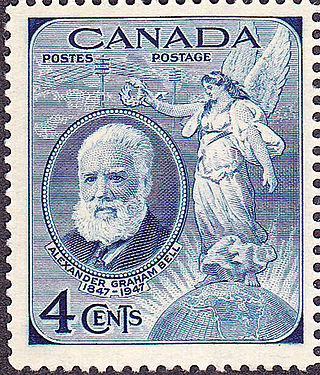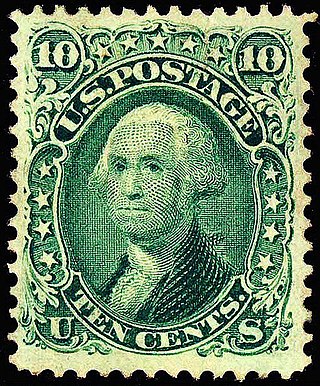
Art Deco, short for the French Arts décoratifs, is a style of visual arts, architecture, and product design, that first appeared in Paris in the 1910s, and flourished in the United States and Europe during the 1920s to early 1930s. Through styling and design of the exterior and interior of anything from large structures to small objects, including how people look, Art Deco has influenced bridges, buildings, ships, ocean liners, trains, cars, trucks, buses, furniture, and everyday objects including radios and vacuum cleaners.

Philately is the study of postage stamps and postal history. It also refers to the collection and appreciation of stamps and other philatelic products. While closely associated with stamp collecting and the study of postage, it is possible to be a philatelist without owning any stamps. For instance, the stamps being studied may be very rare or reside only in museums.

A postage stamp is a small piece of paper issued by a post office, postal administration, or other authorized vendors to customers who pay postage. Then the stamp is affixed to the face or address-side of any item of mail—an envelope or other postal cover —which they wish to send. The item is then processed by the postal system, where a postmark or cancellation mark—in modern usage indicating date and point of origin of mailing—is applied to the stamp and its left and right sides to prevent its reuse. Next the item is delivered to its addressee.

Stamp collecting is the collecting of postage stamps and related objects. It is an area of philately, which is the study of stamps. It has been one of the world's most popular hobbies since the late nineteenth century with the rapid growth of the postal service, as a stream of new stamps was produced by countries that sought to advertise their distinctiveness through their stamps.
The Scott catalogue of postage stamps, published by Scott Publishing Company, now a subsidiary of Amos Media, is updated annually and lists all the stamps of the world that its editors recognize as issued for postal purposes. It is published in fourteen large volumes that include twelve volumes containing all the countries of the world that have ever issued postage stamps, the United States Specialized Catalog, and the 1840–1940 Classic Specialized Catalogue. The numbering system used by Scott to identify stamps is dominant among stamp collectors in the United States, Canada and Mexico.

Postal service in the United States began with the delivery of stampless letters whose cost was borne by the receiving person, later encompassed pre-paid letters carried by private mail carriers and provisional post offices, and culminated in a system of universal prepayment that required all letters to bear nationally issued adhesive postage stamps.
This is a survey of the postage stamps and postal history of Iceland. Regular mail service in Iceland was first established by a charter of 13 May 1776, and on 1 January 1873, Iceland issued its first postage stamps. The design was the same as for the Danish numeral issue of the time, denominated with values ranging from 2 to 16 skilling, and inscribed ÍSLAND. All are scarce or rare, and used copies are especially hard to find.

A commemorative stamp is a postage stamp, often issued on a significant date such as an anniversary, to honor or commemorate a place, event, person, or object. The subject of the commemorative stamp is usually spelled out in print, unlike definitive stamps which normally depict the subject along with the denomination and country name only. Many postal services issue several commemorative stamps each year, sometimes holding first day of issue ceremonies at locations connected with the subjects. Commemorative stamps can be used alongside ordinary stamps. Unlike definitive stamps that are often reprinted and sold over a prolonged period of time for general usage, commemorative stamps are usually printed in limited quantities and sold for a much shorter period of time, usually, until supplies run out.

An airmail stamp is a postage stamp intended to pay either an airmail fee that is charged in addition to the surface rate, or the full airmail rate, for an item of mail to be transported by air.
Francisco Eppens Helguera was a Mexican artist known for his paintings, murals and sculptures of images and scenes distinctly Mexican. He also achieved international fame for his award winning modern designs for Mexican postage and revenue stamps (1935–1953) and for his 1968 redesign of the Mexican coat of arms, still used today on Mexican government documents, coins and the national flag.

The Mexican postal system has its roots in the Aztec system of messengers which the Spanish adopted after the Conquest. A postal service was established in 1580, mainly to communicate between the viceroyalty of New Spain with the motherland Spain. During the 18th century, Spain established a formal postal system with regular routes. In 1856, Mexico issued its first adhesive postage stamps, with "district overprints", a unique feature among postal systems worldwide, employed to protect from theft of postage stamps.

The postage stamps of Ireland are issued by the postal operator of the independent Irish state. Ireland was part of the United Kingdom of Great Britain and Ireland when the world's first postage stamps were issued in 1840. These stamps, and all subsequent British issues, were used throughout Ireland until the new Irish Government assumed power in 1922. Beginning on 17 February 1922, existing British stamps were overprinted with Irish text to provide some definitives until separate Irish issues became available within the new Irish Free State. Following the overprints, a regular series of definitive stamps was produced by the new Department of Posts and Telegraphs, using domestic designs. These definitives were issued on 6 December 1922, the day that the Irish Free State officially came into existence; the first was a 2d stamp, depicting a map of Ireland. Since then new images, and additional values as needed, have produced nine definitive series of different designs.

Postage stamps and postal history of the Canal Zone is a subject that covers the postal system, postage stamps used and mail sent to and from the Panama Canal Zone from 1904 up until October 1978, after the United States relinquished its authority of the Zone in compliance with the treaty it reached with Panama.

The postal history of Turkey and its predecessor state, the Ottoman Empire, dates to the 18th century when foreign countries maintained courier services through their consular offices in the Empire. Although delayed in the development of its own postal service, in 1863 the Ottoman Empire became the second independent country in Asia to issue adhesive postage stamps, and in 1875, it became a founding member of the General Postal Union, soon to become the Universal Postal Union. The Ottoman Empire became the Republic of Turkey in 1923, and in the following years, its postal service became more modernized and efficient and its postage stamps expertly designed and manufactured.
With the advent of robotic and human spaceflight a new era of American history had presented itself. Keeping with the tradition of honoring the country's history on U.S. postage stamps, the U.S. Post Office began commemorating the various events with its commemorative postage stamp issues. The first U.S. Postage issue to depict a U.S. space vehicle was issued in 1948, the Fort Bliss issue. The first issue to commemorate a space project by name was the ECHO I communications satellite commemorative issue of 1960. Next was the Project Mercury issue of 1962. As U.S. space exploration progressed a variety of other commemorative issues followed, many of which bear accurate depictions of satellites, space capsules, Apollo Lunar Modules, space suits, and other items of interest.

Presidents of the United States have frequently appeared on U.S. postage stamps since the mid-19th century. The United States Post Office Department released its first two postage stamps in 1847, featuring George Washington on one, and Benjamin Franklin on the other. The advent of presidents on postage stamps has been definitive to U.S. postage stamp design since the first issues were released and set the precedent that U.S. stamp designs would follow for many generations.

Clair Aubrey Huston was chief postage stamp designer at the United States Bureau of Engraving and Printing (BEP) early in the 20th century. He was the great-grandson of Michael Leib (1759–1822), an American physician and politician. Huston worked at the BEP for more than 21 years and was the designer of numerous United States postage issues.
The 1918 Curtiss Jenny Air Mail Stamps were a set of three Airmail postage stamps issued by the United States in 1918. The 24¢ variety was the first of the stamps to be issued, and was in fact, America's first Airmail stamp.. The 16¢ and 6¢ varieties were issued later in the year to reflect reductions in the postage rate. It features the image of the Curtiss JN-4 airplane.

The 1930 Graf Zeppelin stamps were a set of three airmail postage stamps, each depicting the image of the Graf Zeppelin, issued by the United States Post Office Department in 1930, exclusively for delivery of mail carried aboard that airship. Although the stamps were valid for postage on mail sent on the Zeppelin Pan American flight from Germany to the United States, via Brazil, the set was marketed to collectors and was largely intended to promote the route. 93.5% of the revenue generated by the sale of these stamps went to the Zeppelin Airship Works in Germany. The Graf Zeppelin stamps were issued as a gesture of goodwill toward Germany. The three stamps were used briefly and then withdrawn from sale. The remainder of the stock was destroyed by the Post Office Department. Due to the high cost of the stamps during the Great Depression, most collectors and the general public could not afford them. Consequently, only about 227,000 of the stamps were sold, just 7% of the total printed, making them relatively scarce and prized by collectors.

The Series of 1902, also known as the Second Bureau Issue, is a set of definitive postage stamps in fourteen denominations ranging between one cent and five dollars, produced by the U. S. Bureau of Engraving and Printing and issued by the United States Post Office. Two denominations appeared in November and December 1902 and the other twelve were released between January and June 1903. These stamps were assigned the Scott Catalogue numbers 300 through 313. Also considered part of the series is a fifteenth stamp which appeared in November 1903—a second version of the 2¢ value, the original having faced severe criticism. This series, particularly noted for its exceptional ornateness and opulence of design, remained in circulation until late 1908, when it was superseded by the Washington-Franklin Issues.




















